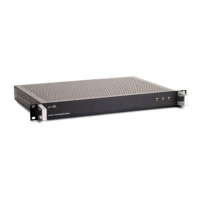EPSILON CLOCK MODEL EC20S Spectracom
73 User’s Manual
then transits to 0D reception mode. That means that the GNSS
receiver tracks only one satellite channel and then improves the
accuracy of the time.
- Stationary The GNSS antenna is stationary and its accurate position is input
by the user. The accurate position so input is then set in the
GNSS receiver which then transits to 0D reception mode. That
means that the GNSS receiver tracks only one satellite channel
and then improves the accuracy of the time.
- Mobile The GNSS antenna is not stationary. The GNSS receiver
computes and delivers the antenna position every second so
that the EC20S (with the GNSS antenna) can be moved. In this
case, the GNSS receiver doesn’t transit to the 0D reception
mode.
79. GNSS LATITUDE, GNSS LONGITUDE, GNSS ALTITUDE
Geographical coordinates of the stationary GNSS antenna position that is applied in the
GNSS Stationary mode (see above GNSS Mode).
Unity: Latitude and Longitude in degrees-minutes-seconds-milliseconds (for the web
interface) and milliseconds only (for the SNMP interface). Altitude in meters (for both web
and SNMP interface).
80. GPS CONSTELLATION
Defines whether the GPS satellites constellation is part of the GNSS synchronization source
or not:
- Yes The GPS satellites constellation is part of the GNSS
synchronization source.
- No The GPS satellites constellation is not part of the GNSS
synchronization source.
81. GLONASS CONSTELLATION
Defines whether the GLONASS satellites constellation is part of the GNSS synchronization
source or not.
- Yes The GLONASS satellites constellation is part of the GNSS
synchronization source.

